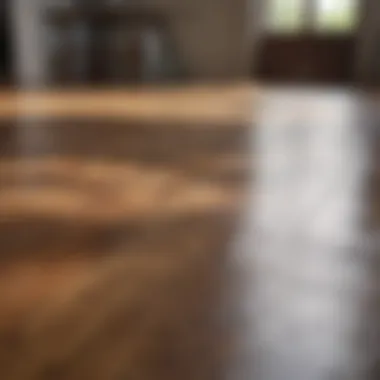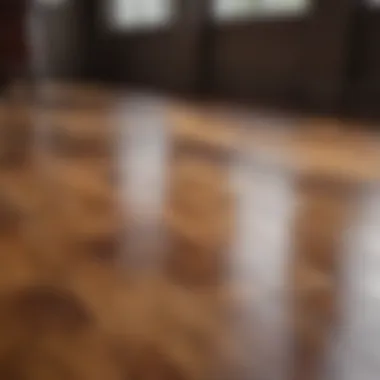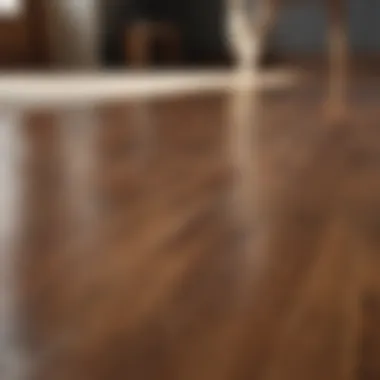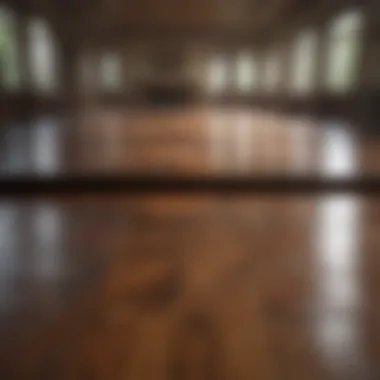Natural Cleaning Solutions for Hardwood Floors


Intro
Hardwood floors are a hallmark of elegance and durability in home design. However, maintaining them requires careful consideration and the right cleaning solutions. Many commercial cleaners can be harsh on these beautiful surfaces, potentially leading to long-term damage. This is where natural cleaning solutions come into play. They are effective, eco-friendly, and can easily be made with items found in your home.
The focus of this article is on these natural alternatives, examining how they help in preserving the finish and integrity of hardwood floors. We will explore various ingredients used in these solutions, the process for cleaning, and tips for ensuring the longevity of your hardwood surfaces. By the end, readers will have a thorough understanding of how to care for their floors while being mindful of environmental impact.
It's important to realize that many conventional cleaning products are not only harmful to the floor's finish but also to the environment. Choosing natural cleaning solutions can provide the best of both worlds: keeping your hardwood floors in excellent condition while embracing non-toxic practices. Let's delve into the cleaning methods that champions both aesthetics and sustainability.
Understanding Hardwood Floors
Hardwood floors represent a significant investment in any home. Their aesthetic appeal and durability often make them a preferred choice for many homeowners. However, understanding hardwood floors goes beyond merely appreciating their beauty.
The way hardwood flooring is constructed and treated can determine its maintenance requirements and resilience over time. This knowledge is essential for selecting the right cleaning solutions and for upholding the floor's integrity.
Moreover, there are different types of hardwood flooring, each with unique characteristics that affect care routines. By gaining a deeper understanding of hardwood flooring, homeowners can better appreciate its advantages while also recognizing the potential challenges in maintaining its appearance and longevity.
Types of Hardwood Flooring
Hardwood flooring can broadly be classified into two categories: solid hardwood and engineered hardwood.
- Solid Hardwood: This type consists of solid pieces of wood that are generally around three-quarters of an inch thick. Due to its composition, solid hardwood can be refinished multiple times, allowing for extensive wear and relatively long lifespans. However, it is sensitive to moisture and extreme temperature changes, requiring careful maintenance.
- Engineered Hardwood: Engineered hardwood is made from layers of wood, with a top veneer of real hardwood. This design makes it more stable than solid hardwood, especially in humid or fluctuating temperature environments. Engineered options can also be more affordable while still delivering a similar aesthetic.
Understanding these differences is crucial when choosing a cleaning solution, as solid hardwood may require more gentle care compared to engineered versions, which can often handle more intensive cleaning methods.
Common Challenges in Hardwood Maintenance
Maintaining hardwood floors entails addressing several challenges, primarily related to wear and tear over time. Some of the prominent issues include:
- Scratches and Dents: These can occur from foot traffic, furniture, or pets. Continuous exposure to rough surfaces can diminish the floor's appearance and integrity.
- Water Damage: Excess moisture can lead to warping, staining, and other forms of damage. Proper cleaning techniques and choosing suitable products are essential to mitigate this risk.
- Dust and Grime Buildup: Wood floors can accumulate dust, dirt, and allergens, which not only affect aesthetics but also indoor air quality. Regular cleaning is crucial for a healthy living environment.
- Fading Colors: Sunlight can cause certain finishes to fade over time, drawing attention to the need for protective measures.
By understanding these challenges, homeowners can be more proactive in implementing maintenance routines and leveraging natural cleaning solutions effectively.
The Need for Natural Cleaning Solutions
Maintaining hardwood floors involves much more than just regular sweeping and mopping. The type of cleaning products used can have significant implications for both the floor's longevity and the surrounding environment. The need for natural cleaning solutions arises from a combination of ecological, health, and aesthetic factors that are especially relevant today.
Environmental Impact of Chemical Cleaners
Chemical cleaners, while often effective, pose environmental risks that cannot be ignored. Many conventional cleaners contain volatile organic compounds (VOCs) that contribute to air pollution. These substances can evaporate easily, leading to smog formation and contributing to respiratory issues for both indoor and outdoor environments.
Moreover, chemical cleaners often involve harmful ingredients that do not easily break down. When these cleaners enter the water systems, they can harm aquatic life and disrupt local ecosystems. Using natural cleaning solutions mitigates these risks. Ingredients like vinegar and baking soda are biodegradable, meaning they pose little threat to the environment when disposed of properly.
Chemical cleaners can also be harmful to the structure of hardwood floors. They may strip away finishes, dulling the appearance over time, while natural solutions preserve the protective coatings effectively.
Health Concerns Related to Harsh Chemicals


Harsh chemicals in cleaning products can have immediate and long-term health effects on humans. Many people experience allergic reactions or respiratory issues when using products that emit strong odors or contain irritating substances.
Furthermore, long-term exposure to these chemicals has been linked to more serious health conditions such as asthma, hormonal imbalances, and even certain types of cancer. For families with pets or young children, using natural cleaners becomes even more crucial. Natural solutions are safer and reduce the risk of chemical exposure, making the home environment healthier.
Natural cleaning solutions, such as those containing simple components like vinegar or essential oils, provide effective alternatives that can keep hardwood floors clean without jeopardizing health. They demonstrate that effective cleaning does not necessarily require toxic chemicals.
"Choosing natural over chemical cleaners is an investment in both your health and the environment."
Integrating these considerations into your cleaning routines will lead to more sustainable practices and healthier living spaces. It is vital to adopt methods that protect both wood surfaces and the surrounding environment.
Key Ingredients in Natural Cleaning Products
Using natural ingredients for cleaning hardwood floors is vital. These components possess properties that effectively clean while being safe for the environment and human health. Understanding these key ingredients empowers homeowners to make informed decisions. Utilizing natural solutions not only prolongs the life of floors but also minimizes exposure to toxic chemicals.
Vinegar: A Versatile Cleaner
Vinegar is widely recognized as a natural disinfectant. The acetic acid in vinegar helps break down dirt and grease. When mixed with water, it creates a powerful cleaner that removes grime from hardwood surfaces without leaving harmful residues. It is essential to dilute vinegar before applying, as its potency can damage certain finishes. A common mix is one part vinegar to three parts water. This solution can be applied with a mop or cloth, aiding in regular maintenance.
Olive Oil: For Shine and Protection
Olive oil is not just a kitchen staple; it also serves as an excellent natural polish for hardwood floors. Its moisturizing properties help to nourish the wood. A simple mixture of olive oil and vinegar can provide both cleaning and protection. Applying this mixture enhances shine and protects against damage from water and dirt. When using olive oil, moderation is key to avoid leaving a sticky residue.
Baking Soda: For Stains and Odors
Baking soda is famed for its deodorizing capabilities. It is particularly useful for eliminating odors from hardwood floors. To tackle stubborn stains, a paste made of baking soda and water can be applied directly to the affected area. After allowing it to sit for a short while, the paste can be wiped off, revealing a cleaner surface. In addition, it can be sprinkled on the floor before sweeping to absorb odors.
Essential Oils: Adding Aroma and Benefits
Essential oils are natural extracts available in various scents. They not only provide a pleasant aroma when cleaning but also offer antibacterial properties. Lavender, tea tree, and lemon oils are popular choices for adding fragrance while enhancing cleaning effectiveness. A few drops in a cleaning solution can transform the experience of basic cleaning tasks. However, it is important to ensure that essential oils are safe for the specific finish of the hardwood floors.
Natural cleaning solutions represent an effective approach to maintain hardwood floors while promoting ecological responsibility. The DIY segment of cleaning solutions is particularly important as it offers several advantages over commercial options. First, these solutions are free from harmful chemicals, reducing the risk to both health and the environment. Second, making cleaning solutions at home can be cost-effective. Most ingredients tend to be common household items that are readily available, minimizing the need for specialized products.
Moreover, DIY cleaners allow for customization. Homeowners can modify the ingredients based on specific cleaning needs or personal preferences. This flexibility can lead to potent solutions that cater to the unique characteristics of individual hardwood flooring.
Lastly, using natural solutions aligns with sustainable living practices. This is a significant consideration in today’s world where environmental conservation is paramount.
Basic Vinegar Solution
A basic vinegar solution stands out as a cornerstone in natural cleaning practices for hardwood floors. Vinegar's anti-bacterial properties make it a strong candidate for effectively removing dirt and grime. To create this solution, you only need white vinegar and water.
Recipe:
- Mix one part vinegar with three parts water in a spray bottle.
- Shake gently to combine.
- Your cleaner is now ready to use.
Spraying it directly onto a microfiber mop or cloth is advisable to avoid excess moisture on the floor. This ensures the wood remains safe from potential water damage. Vinegar’s acid can help lift stains while leaving a streak-free finish. However, it is crucial to avoid using vinegar in concentrated amounts as it can damage the finish on lacquered hardwood floors.
Olive Oil and Vinegar Polish


Combining olive oil and vinegar creates a natural polish that nourishes hardwood floors while adding essential shine. Olive oil acts as a conditioner, helping to prevent drying and cracking of the wood. The vinegar component maintains cleanliness and enhances shine.
Recipe:
- In a spray bottle, mix one cup of olive oil with half a cup of white vinegar.
- Shake well before each use.
Applying this polish with a soft cloth allows for an even distribution. It is optimal to work in small sections and buff with a dry cloth afterward for a fine finish. However, this solution should only be used occasionally to avoid buildup on the floor.
Baking Soda Paste for Stains
Baking soda is another versatile natural cleaning ingredient. Its mildly abrasive quality allows it to tackle tough stains on hardwood floors effectively. A baking soda paste is particularly useful in situations where spills have occurred or stains have set into the wood.
Recipe:
- Combine three tablespoons of baking soda with two tablespoons of water to form a paste.
- Apply it directly to the stained area, allowing it to sit for 5-10 minutes.
- Gently scrub with a soft cloth or sponge, then wipe clean with a damp cloth.
This approach not only removes stains but also neutralizes odors. It's important to rinse thoroughly after using the paste to avoid residue that may leave floors feeling gritty.
Step-by-Step Cleaning Process
A structured approach to cleaning hardwood floors ensures effective maintenance while preserving their natural beauty. This section outlines the importance of following a systematic cleaning process for hardwood floors. The objective is to minimize the risk of damage and maximize the efficacy of natural cleaning solutions. Attention to detail in your cleaning regimen can lead to visually appealing results and prolong the life of your investments.
Preparing Your Hardwood Floors
Before applying any cleaner, it is crucial to prepare your hardwood floors correctly. This initial step sets the stage for successful cleaning.
- Remove loose debris: Start by sweeping or vacuuming the surface to remove dust, dirt, and pet hair. Using a soft-bristle broom or a vacuum with a hardwood floor attachment is advisable. This helps prevent scratching.
- Inspect for damage: Look for any potential imperfections such as scratches or dents. Identifying these will give insight into whether a specific area needs additional attention or repair.
- Clear the area: Move furniture and other obstacles from the floor. This allows for an unobstructed cleaning area and avoids stains from furniture being put back down too soon.
Applying Natural Cleaning Solutions
Once the area is prepped, the next step involves applying your chosen natural cleaning solution. Different solutions suit varying levels of dirt and finish types, so choose wisely. Here are two methods:
- Vinegar Solution: Mix equal parts vinegar and warm water in a spray bottle. Use a microfiber mop to apply the solution sparingly. Avoid saturating the wood as excess water may cause warping.
- Olive Oil Polish: For maintaining shine, mix one part olive oil with two parts vinegar. Apply it lightly using a clean cloth. This not only cleans but also nourishes the floor.
It is essential to test any cleaning mixture on a small, hidden section of the floor first. This ensures no adverse reaction occurs with your finish.
Drying and Finishing Touches
After the application of your cleaning solution, the final step is drying and making any needed finishing touches. This is vital to protect and maintain the look of your hardwood floors.
- Dry with a clean cloth: Use an absorbent cloth to wipe up any leftover moisture. This prevents any excessive dampness that could seep into the wood.
- Air circulation is important: Allow for proper air circulation in the area. Open windows or use fans to help speed up the drying process. This will further prevent any mildew or potential damage.
In summary, a meticulous step-by-step cleaning process allows homeowners to maintain the beauty and integrity of hardwood floors using natural solutions. This not only enhances the appearance but also contributes to a healthier living environment.
Maintaining Hardwood Floors Between Deep Cleans
Maintaining hardwood floors between deep cleans is key to preserving their beauty and longevity. Regular care helps prevent dirt buildup and minimizes wear. Unlike other floor types, hardwood requires specific attention due to its susceptibility to scratches and moisture. Ignoring routine maintenance can lead to costly refinishing or premature replacement.


There are certain practices that can be adopted to keep hardwood floors looking their best without needing frequent deep cleaning. These practices not only enhance the appearance but also protect the wood from potential damage.
Routine Cleaning Practices
Regular cleaning is vital. Here are some basic practices to consider:
- Sweep or dust mop frequently: Use a soft-bristle broom or a microfiber mop to prevent dust and dirt from scratching the surface.
- Vacuum regularly: A vacuum specifically designed for hardwood floors can remove finer particles that sweeping may miss. Ensure that the vacuum does not have a beater bar, as this can scratch the finish.
- Wipe up spills immediately: Liquid spills can damage the finish or seep into the wood. Use a soft, damp cloth to clean spills right away.
- Use a natural cleaning solution occasionally: Even between deep cleans, a light cleaner made from vinegar and water can refresh the surface and remove any stubborn spots.
Maintaining this routine ensures that dirt and grime do not accumulate, keeping the floor clean and appealing. The process is quick and can be integrated into your weekly cleaning schedule without too much disruption.
Preventing Damage from Foot Traffic and Furniture
Foot traffic and furniture can pose significant risks to hardwood floors. To mitigate potential damage, consider the following strategies:
- Use floor mats: Place mats at entrances to reduce the amount of dirt and moisture tracked onto the floor.
- Limit high heels and abrasive shoes: Encourage family members and guests to remove shoes or to wear soft-soled footwear inside the home.
- Protect furniture legs: Attach felt pads to the bottoms of chairs and tables to prevent scratching. Regularly check these pads for wear and replace them as needed.
- Arrange furniture thoughtfully: Avoid heavy or frequent shifting of furniture, which can cause dents and scratches. Instead, plan the layout to minimize movement.
By following these recommendations, homeowners can significantly reduce the risk of damage from daily activities. These simple steps contribute to the overall health of hardwood floors, extending their lifespan and maintaining their aesthetics.
"Routine maintenance is essential for the longevity of hardwood floors. Simple actions today prevent major repairs tomorrow."
Tips for Enhancing the Longevity of Hardwood Floors
Maintaining the integrity of hardwood floors is crucial for both aesthetic appeal and functionality. Proper care can extend their life and preserve their beauty. Several practical strategies can achieve this goal. Not only do these methods prevent damage but also help retain the value of the investment. The importance of these practices should not be underestimated if you aim for lasting elegance in your home.
Using Rugs and Mats Strategically
One effective way to protect hardwood floors is by utilizing rugs and mats in high-traffic areas. Placing area rugs at entry points can significantly reduce the amount of dirt and moisture that enters the living space. Furthermore, these rugs act as a barrier that absorbs impact from foot traffic, preventing scratches and scuffs on the floor surface. Additionally, mats in front of sinks and appliances can protect against spills and stains, ensuring that your hardwood floor remains in top condition.
When selecting rugs, consider non-slip options to prevent accidents. Make sure to choose materials that will not damage the finish of the wood, as some fibers can cause abrasions over time. Regular cleaning of the mats is equally important, as trapped debris could potentially scratch the surface when walked on.
Humidity Control and Temperature
Another critical factor in the longevity of hardwood floors is controlling humidity and temperature levels in your home. Wood is a natural material that reacts to changes in the environment; excessive moisture or low humidity can cause warping or cracking. Maintaining a consistent humidity level between 40% and 60% is advised. Using a dehumidifier in humid months and a humidifier during dry seasons can help.
Temperature also plays a role. Keeping your home at a stable temperature, ideally between 60°F and 80°F, can minimize the risk of damage. Avoid placing furniture directly against the walls, as this can trap moisture and lead to mold growth.
Properly managing humidity and temperature not only protects your hardwood floors but also enhances the overall comfort of your environment.
Epilogue
When considering the maintenance of hardwood floors, the choice of cleaning solutions holds significant importance. This article underscores the relevance of using natural cleaning solutions, promoting both the welfare of the environment and the health of individuals. The decision to go natural with cleaning methods not only helps in preserving the integrity of hardwood surfaces but also contributes to a broader sustainable lifestyle.
The Benefits of Going Natural
Opting for natural cleaning solutions comes with numerous advantages. First, these products tend to be safer for both the user and any inhabitants of the home. Many chemical cleaners contain substances that can irritate the skin, respiratory system, and even impact long-term health. Natural alternatives, such as vinegar and baking soda, provide effective cleaning without harmful side effects.
Furthermore, natural ingredients are typically biodegradable. This means they do not contribute to environmental pollution. When washed down the drain, they break down into non-toxic components, reducing the ecological footprint of regular cleaning practices. The quality of hardwood floors can also improve, as natural cleaners do not leave behind harmful residues that can wear down the finish over time.
Embracing Sustainable Living Practices
Embracing natural cleaning solutions is an integral part of a sustainable living approach. Sustainable practices encourage individuals to be mindful of their choices and their effects on the planet. When homeowners switch to natural cleaning options, they support a movement towards reducing the number of harsh chemicals entering the home and eventually the environment.
Engaging in this practice promotes the idea of resourcefulness. Many natural cleaning ingredients are common household items, making it easy to maintain floors without purchasing specialized products. In addition, it supports local economies, as many natural cleaning products are created by smaller, local businesses rather than large corporations.















